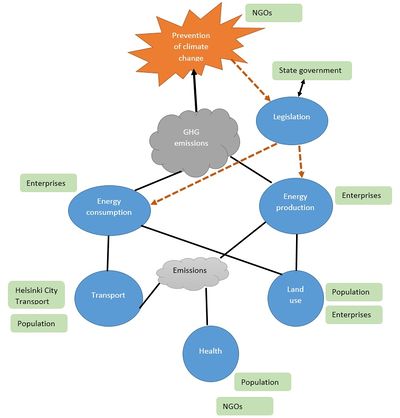User:Mari Malinen
Homework 1
What is shared understanding?
- All participants understand what decision options are considered, desired outcomes, objectives, facts, opinions and disagreements exist and why. Also why a certain decision option is selected.
- Everyone understands the whole picture without having to agree with each other.
What different purposes are there for participation in assessment and/or decision making?
- Openness builds trust among participants and outside observers.
- To make sure all relevant issues are raised and handled properly
- Through successful critique invalid statements can be ruled out from the assessment
What is benefit-risk assessment?
- Analyzing different scientific data to compare benefits and risks of an event, activity, food etc.
- For example assessing use of food additives: do the benefits outweigh possible risks?
←--#: . OK. --Jouni (talk) 10:09, 23 March 2015 (UTC) (type: truth; paradigms: science: defence)
Homework 2
- What could an Universal object be in an assessment?
- Is the Training assessment similar to the assignment we are going to do during the course?
DARM 2015 Homework 4
| Moderator:Mari Malinen & Anni Hartikainen (see all) |
| This page is a stub. You may improve it into a full page. |
| Upload data
|
Scope
Question
- What measures can be taken in Helsinki Metropolitan area to control climate change by reducing greenhouse gas emissions?
- How to reduce the per capita carbon dioxide emissions of the Helsinki Metropolitan Area by 39 per cent of the 1990 level by the year 2030?
Intended use and users
Helsinki Metropolitan area city authorities
Participants
- Cities of Helsinki, Espoo, Vantaa and Kauniainen
- A broad range of environmental protection, planning, traffic and public transport specialists from the cities
- YTV specialists in traffic, solid waste management and regional development
- representatives of energy companies
- interest groups
Boundaries
- Area: Helsinki Metropolitan area (Helsinki, Espoo, Vantaa and Kauniainen)
- Time: Based on years 1990, 2000 and 2004. Estimations made for year 2030.
- Considered sources of GHG emissions:
- Electric heating
- consumption electric power
- transport, district heating
- separate heating
- industry and machinery
- treatment of solid waste and waste water
Decisions and scenarios
Three considered scenarios
1. Business as usual
- Emission levels will stay roughly the same
- Emissions from transport increase, but new legislation improves e.g. energy efficiency
2. Reducing GHG emissions 39 % from the 1990 emission level
3. Continued rapid growth in electricity consumption
- If energy consuption grows according to forecasted trend, 5 % growth in GHG emissions by 2030 from the 2004 level
Timing
- The decision should be made as soon as possible to achieve best GHG emission reduction
Answer
Results
Trasportation
- Encourage use of public transport
- Improving competiveness of public transport
- National taxation policy towards choise of low-emission vehicles
Land use
- Location of dwellings, workplaces and services to decrease need for trasport
- growth of traffic and access to district heating
- Access to public transport
Electricity consumption
- Improving the awareness of resindents towards more efficient electricity consumption
- Cities should put a high value to energy efficiency of appliances
Heating of buildings
- Promoting district heating and cooling
- Correct use and maintanance of buildings
Procurement, consumption and waste
- Promoting material and energy efficiency and low emissions in city procurement
- Prevent solid waste formation
- Advice population how to avoid solid waste
- Enhancing material recycling
Energy generation and distribution
- Enhancing centralised cogeneration of electricity in Helsinki Metropolitan area
- Promoting eco-efficiency and renewable energy sources of decentralised energy generation
Conclusions
With the proposed improvements listed above it is possible to reach scenario 2: Reducing GHG emissions 39 % from the 1990 emission level.
The measures will be a drain on resources but doing nothing would be even more costly.
Rationale
Stakeholders
- Cities of Helsinki, Vantaa, Espoo and Kauniainen
- Citizens of Helsinki, Vantaa, Espoo and Kauniainen
- Enterprises e.g. energy producers, building companies, waste management
- Responsible city agencies e.g. environmental agencies, premises center, building supervision, Helsinki City Transport
- State government
- NGOs
Dependencies
Analyses
Indices
Calculations
See also
Keywords
References
Climate Strategy 2030 of Helsinki Metropolitan Area
Related files
DARM 2015 Homework 5
Questions:
- What are the aims/goals of the strategy/program, i.e. what are the desired impacts and outcomes striven for?
- Who are those that benefit if the aims/goals of the strategy/program are reached?
- What are the actions that are needed/intended to take in order to progress towards the aims/goals?
- Who are those that actually realize these actions?
- What are the decisions that are needed to make in order to enable/promote the actions?
- Who are the decision makers?
- What direct or indirect health impacts, positive or negative, these decisions and actions (may) have?
- Where and how do these impacts take place, who are those that face these health impacts in practice?The community,the citizens,
- Are the health impacts big or small in relation to other impacts (e.g. economical, social, climate, other environmental, ...)?
- Do the intended policies result in win-win, win-lose, lose-win, or lose-lose situations with regard to health and other impacts?
- Formulate a plausible and meaningful specific assessment question that takes account of (some of) the aspects considered in above questions.
- Extra question: In what ways your answers do or do not represent "shared understanding"? (The climate program/strategy can be considered a compilation of contributions by many experts and attempting to reflect the views and needs of different decision makers and stakeholders).
